dow 4x
| Dieses 4fach Monokular mit Montagefüßen für eine Einheitspeilscheibe (PSE) der Wehrmacht (2. Weltkrieg) ähnelt den 4x20 Monokularen der Blinkgeräte. Die Beschriftung des oberen Deckels lautet "dow", das ist die Herstellercode aus dem 2. Weltkrieg für die "Waffenwerke Brünn A.G." (oder Opticotechnica GmbH) in Prerau, Tschechien, sowie "M.F. 4x" (= Monokulares Fernglas 4x) und der Seriennummer 3253 bzw. 7760. Das blaue Dreieck kennzeichnet ein kälte- und hitzebeständiges Schmierfett. Im Okular befindet sich eine Strichplatte mit einem senkrechten Peilfaden. Das Okular hat eine Dioptrienmarkierung von plus und minus sowie Null. Die Augenmuschel ist aus Kunststoff, die Deckel schwarz lackiert und das Gehäuse mit strukturierter Oberfläche ist mit einem anthrazit-farbenem Lack ummantelt. Letzteres ist typisch für militärische Gläser. Das 3253-Modell hat am Objektivring einen zusätzlichen Ring mit wegklappbaren Filterglas anmontiert. Der Filter ist graugrün und dient als Blendschutz. | This 4x monocular with mounting stumps was made for a bearing circle of the "Wehrmacht" (German army, WWII; "Einheitspeilscheibe" = PSE [unified bearing circle]). It resembles the 4x20 monoculars of the Blink apparatuses. The markings on the top cover are: "dow", i.e. the maker code during WWII for "Waffenwerke Brunn A.G." (or Opticotechnica GmbH) in Prerau, Czech region, as well as "M.F. 4x" (= Monocular Field-glas 4x) and S/N 3253 or 7760. The blue triangle denotes a special frost and heat resistant grease. There is a reticle in the eyepiece; a vertical line. The ocular has some dioptre markings of plus, minus and zero. The eyecup is made of plastic. The cover plates are painted black. The body has a textured surface and is painted with a greyish or anthracite lacquer, being typical for military glasses. The 3253 model comes with a grey green filter glass which can be swung in front of the objective as ray-shade. The filter is mounted on a ring that is screwed onto the objective frame. |
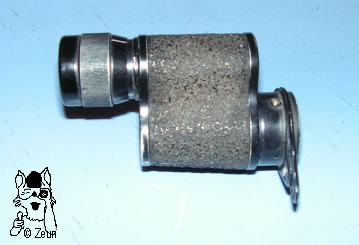
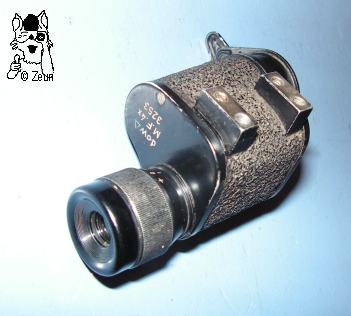
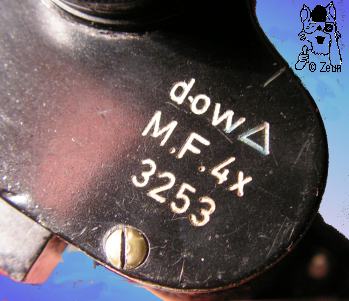
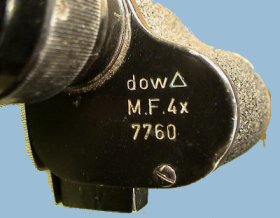
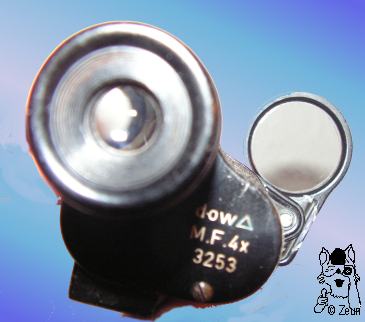

| Das Monokular ist 8cm bzw. 8,6 cm lang, misst 40x40mm oben und 43x43mm unten am Gehäuse. Das Okular und der Ob>jektivring sind 28mm im Durchmesser. Die Filterlinse ist 26mm im Durchmesser. Das M.F. 4x wiegt 100g. | The monocular measures 8cm to 8.6cm in length. The housing is 40x40mm wide at its top, and 43x43mm wide at its bottom. The eyepiece and the objective frame are 28mm, the filter lens 26mm in diameter. The M.F. 4x weighs 100g. |
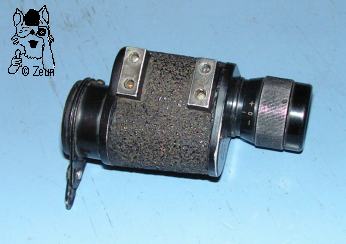
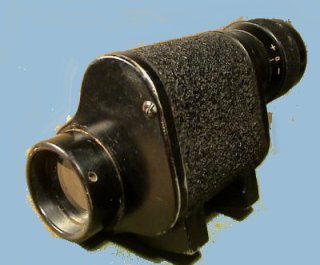
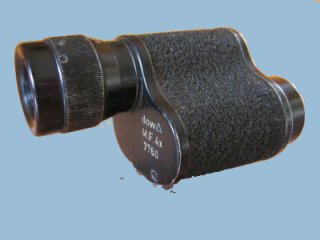
| Die zugehörige Einheitspeilscheibe (PSE) hat einen Kompass mit Blasen-Wasserwaage und 360° Skalen. Auf dem drehbaren Arm an der Oberseite wird das M.F. 4x20 angeschraubt. Dies lässt sich auch kippen und arretieren. An der Unterseite der Peilscheibe befindet isch ein Gewinde zum Aufschrauben auf eine Klemme oder ein Stativ. Zum Transport gab es einen Holzkasten, dessen Beschriftung im Deckel Auskunft über die Zubehörteile gibt (Einheitsstativ, Schraubzwinge, Futteral und Behälter). Die Peilscheiben wurden wohl zumeist von Albert Patin, Berlin hergestellt, deren Gerätecode aus dem 2. Weltkrieg "jlq" ist. | The unified bearing circle (German: PSE = Einheitspeilscheibe) comes with a compass with a bubble level and a 360° scale. The M.F.4x20 was screwed onto the rotating arm on top of the circle. The monocular can also be tilted on it. There is a thread at the bottom of the circle to screw to a clamp or a tripod. A wooden box was used for transport. The paper labels inside the case lid show which accessories were available or came with it (unified tripod, clamp, pouch and case). The bearing circles were mostly made by Albert Patin in Berlin having the WWII military instrument code "jlq". |
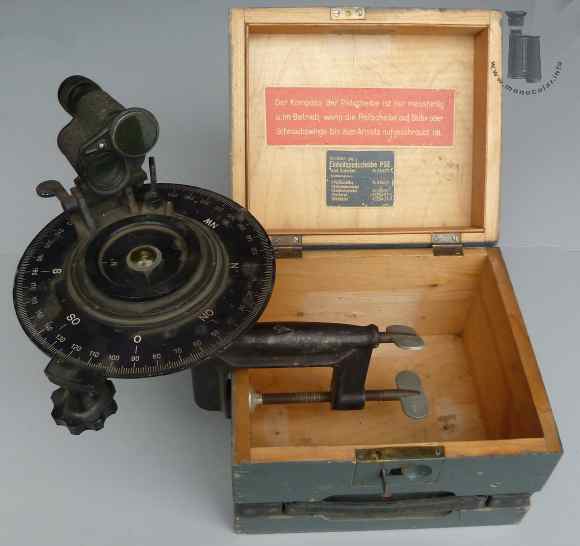
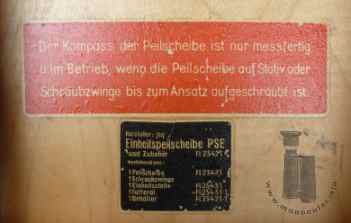
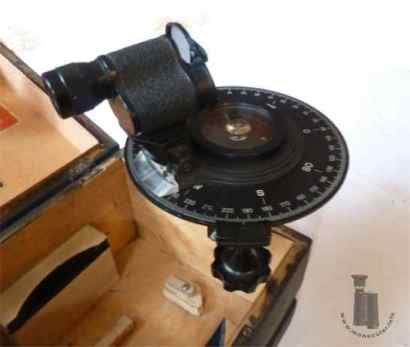
| Zwei weitere dow 4x Monokulare mit Nummern 7285 und 7580 wurden mittels einer selbstgebauten Brücke und Verschraubungen an den Montagefüßchen als binokulares Glas verbunden. | Two other dow 4x monoculars with numbers 7285 and 7580 were connected as binoculars by means of a self-made bridge attached with the mounting screws. |
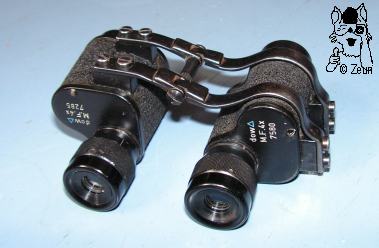
Fotos: Zeun, Ebay

